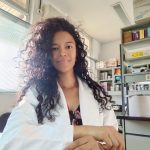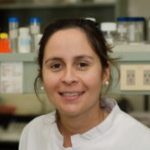- Anaerobic Parasite
- Aquatic Ecology
- Abiotic and biotic stress in plants
- Biochemistry and Physiology of Fruit Ripening
- Bovine and Ovine Biotechnologies
- Cell Biology and Biochemical Parasitology
- Comparative Neuroendocrinology
- Developmental Biology
- Environmental Microbial Ecology Laboratory
- Ichthyophysiology and Aquaculture
- Microorganism Plant Interactions
- Molecular Farming and Vaccines
- Molecular Parasitology
- Mycology and Edible Fungi
- Physiology and Assistance to Plant Breeding
- Phytobacteriology
- Photochemistry and Molecular Photobiology
- Plant Physiology
- Soil Microbiology
- Stem Cells and Gene Therapy
Comparative Neuroendocrinology Laboratory
Head

- Luis Fabián Canosa, PhD - Independent Researcher CONICET. Adjunct Professor UNSAM lcanosa@intech.gov.ar
Staff

- Antonia Rosero Garcí, Eng. Doctoral Fellow AGENCIA I+D+I aroserogarcia@intech.gov.ar
Support Staff

- Agustina Ganuza - CIC Techincal agusganuza@intech.gov.ar
Research Interests
The research interest in my Lab is focused on the endocrine mechanisms that regulate and coordinate growth, with energy balance and reproduction. The long-term goal is to answer how physiological balance is achieved in the face of the competing energetic demands of growth and reproduction using fish as animal model. This multidisciplinary and integrative program involves whole animal as well as in vitro studies, and utilizes physiology, biochemistry, cellular and molecular biology tools.
Research Lines
Pejerrey aquaculture production face a main drawback consisting of low growth and survival rates compared to traditional culture fish species such as carps, tilapia and salmons. In addition, sexual maturation is achieved before reaching commercial size, further reducing growth rates. Thus, it is important to study endocrine regulation of somatic growth in order to develop strategies for improving the growth parameters under culture conditions. In this context, the objective of this research project is to study the regulatory mechanisms of growth and its integration to the control of reproduction and nutrition. To achieve this goal, it is necessary first to establish the regulatory mechanisms for expression and secretion of growth hormones (GH), and then how are they interacting with other physiological process. Giving that GHRH, PACAP and somatostatin (SS) are the main regulators of GH secretion in fish (Canosa et al., 2007), the primary objective is to characterize the molecular variants of these neuropeptides in pejerrey and to stablish which factors regulate their expression. This project would allow us to propose solutions for pejerrey aquaculture.
The somatrotropic axis, made up by the hypothalamus, the pituitary gland, the liver and skeletal muscle, is the main regulatory endocrine system for somatic growth. This axis is regulated by several hormones such as growth hormone (GH), somatomedins (IGF-I e IGF-II), as well as associated binding proteins and receptors. The GH synthesis and release at the pituitary is stimulated by the growth hormone releasing hormone (GHRH), the pituitary adenyl-cyclase activating polypeptide (PACAP) and GH secretagogues such as ghrelin and nesfatin-1, which are also involved in the regulation of food intake. On the other hand, the GH synthesis and release are inhibited by somatostatin (SS), as well as other factors such as serotonin. (Canosa et al., 2007).
The GH effects on growth has two ways of action: one lipolytic and other anabolic. The lipolytic action (IGF independent) is potentiated by catabolic states and malnutrition, improving lipid utilization as energy source. The anabolic action per se (protein synthesis) is mediated, at least in part, by IGFs. In fish, similar to other vertebrates, the GH secretion is negatively controlled by hepatic IGF-I (Pérez-Sánchez y cols., 1992; Blaise y cols., 1995; Weil y cols., 1999). Thus, the nutritional status plays an important role in the regulation of GH secretion (Breier, 1999; Louveau y Bonneau, 2001).
One remaining unexplored question for several fish species for their aquaculture production is to adequate the feeding regime to their growth potential. Similarly, the optimization of nutritional requirements is crucial for successful culture of a new fish specie. Fish growth depends on the presence of essential nutrients in the aquafeeds, being protein one of the most important affecting growth as well as the production cost. In addition, the energy level of the diet is also critical since a low energy diet will promote the protein usage as an energy source. While the usage of hyper-energetic diets has promoted fast growth in same species, in others an increment in adiposity and a poor feed conversion ratio were obtained (Martí-Palanca y cols., 1996). It is important to stablish the optimal levels of proteins, lipids and energy, as well as their ratio to achieve a successful production from the practical and economical point of view. Thus, studding the somatotropic axis will help us to establish, in a more precise way, the nutritional requirement of pejerrey.
Publcations
Boan AF, Delgadin TH, Canosa LF, Fernandino JI. Loss of function in somatostatin receptor 5 has no impact on the growth of medaka fish due to compensation by the other paralogs. General and Comparative Endocrinology 351, 114478. 2024. https://doi.org/10.1016/j.ygcen.2024.114478
Canosa LF, Bertucci JI. The effect of environmental stressors on growth in fish and its endocrine control. Frontiers in Endocrinology 14. 2023. https://doi.org/10.3389/fendo.2023.1109461
Bertucci JI, Blanco AM, Navarro JC, Unniappan S, Canosa LF. Dietary protein:lipid ratio modulates somatic growth and expression of genes involved in somatic growth, lipid metabolism and food intake in Pejerrey fry (Odontesthes bonariensis). Comparative Biochemistry and Physiology Part A: Molecular & Integrative Physiology Part A 270, 111231. 2022. https://doi.org/10.1016/j.
Canosa LF, Bertucci JI. Nutrient regulation of somatic growth in teleost fish. The interaction between somatic growth, feeding and metabolism. Molecular and Cellular Endocrinology 518, 111029. 2020. https://doi.org/10.1016/j.mce.2020.111029
Bertucci JI, Blanco AM, Sánchez-Bretaño A, Unniappan S, Canosa LF. Ghrelin and NUCB2/Nesfatin-1 co-localization with digestive enzymes in the intestine of pejerrey (Odontesthes bonariensis). Anat Rec (Hoboken) 302: 973-982. 2019. https://doi.org/10.1002/ar.24012
Gómez-Requeni P, Kraemer MN, Canosa LF. Dietary lipid requirements of the teleost pejerrey (Odontesthes bonariensis): gene expression of muscle growth biomarkers and the GH/IGF system. Fishes. 4: 37. 2019. https://doi.org/10.3390/fishes4030037